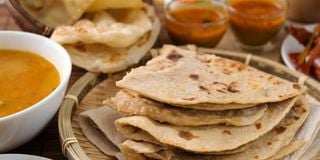Why Kisumu residents cannot afford chapo 'dondo' anymore

Chapati is a staple meal in many homes in Kenya during Christmas.
In 2018, Calvin Roberto, a contracted cleaner at a company with offices in the heart of the Kisumu central business district, could budget well with the money he had for meals and transport.
For the 26-year-old, a lunch of chapati and fried beans, popularly known as madondo, which cost a minimum of Sh70, would be favourable for his pocket. This would be a budget of Sh350 a week, because he did not work on weekends.
He would alter the diet slightly by maybe eating fried sardines, popularly known as omena in the local Dholuo language, which would cost Sh100 at the popular Kwa Joan eatery, located in the then Winmatt, a makeshift minimarket for all businesses.
“During those days, you could at least eat healthy and at a cheaper price. If I was treating myself, I could get beef, indigenous vegetables served with ugali or rice for between Sh120 and Sh150,” said Mr Roberto.
But since 2019, there have been a series of demolitions carried out by the Kenya Railways Corporation to expand and refurbish the Kisumu port, and this saw most of these structures brought down.
Another popular eatery was Lwang’ni, which people used to frequent for fresh tilapia, restaurants along Akamba Line, where there was affordable food including a meal consisting of ugali, a quarter chicken and vegetable salad or kachumbari going for Sh180.
There was also Mama Collo next to Swan Centre. She now rents space in a building in the city. This has definitely affected the price of food being served.
Now Mr Roberto cannot afford the lunch he used to. There are no makeshift eateries and the only cheap lunch is madondo, which now costs between Sh120 and Sh150.
This is also not available anywhere in the city at a lower price than this, as suppliers are mainly hawkers who bring the meal to offices only by order.
“The food vendors complain about the rise in food prices such as cooking oil and the distance they have to cover, as they prepare the meals at home and bring them to town afterwards and distribute them to various offices,” said Mr Roberto.
All eateries on KRC land were brought down. So too did Winmatt, which used to serve thousands of low-income earners working in offices around the city and Maseno University students, who found it affordable because some would go for one chapati and a plate of beans for a total of Sh50.
Mr Roberto proposes that available eateries prepare food for all classes of people at an affordable price.
Apart from KRC, the Kisumu County government also brought down other structures in the city, meaning those who would like to get cheap lunch go to the Kisumu Business Park, a distance of at least one kilometre from the city.
While most people retreated to the makeshift eateries behind the Jaramogi Oginga Odinga Sports Complex (formerly the Jomo Kenyatta Sports Ground), they also suffered after the county government brought them down.
The demolition was part of the redesigning of the city, which has driven the county’s middle class to eating bread and tea in offices for lunch as low-cost eateries are no more.
Then there are the four hotels – Star Acacia Premier Hotel, Kisumu Hotel, Imperial Sarova, and Imperial Express and Mirage – where a meal would cost you at least Sh800, definitely not sustainable for one with a basic pay of Sh10,000 to Sh30,000.
Not everyone can afford the African dishes served in restaurants such as Ranalo Foods K’osewe, Kalongolongo, Adita, Kisumu Food Court, Hangover Ka Akwacha or Billie Restaurants, whose target customers are the wealthy owing to their locations in Milimani, while others are next to the Swan Centre.
Here you must have Sh280 with you to get a plate of ugali and beef. This price differs from one eatery to another and you can pay up to Sh570 or Sh700 for a plate of beef or traditional dishes.
Even one of the cheapest meals, tripe, commonly referred to as matumbo, costs Sh250 or Sh280 in some of these eateries, a meal that used to cost Sh100 in almost all eateries in the CBD.
For a plate of nyama choma, there used to be a popular joint called Kwa Kimani, which after demolitions had to move from the city to Kibuye, next to Sifa House. It charged Sh180 for a plate of quarter nyama choma served with ugali. This has since been raised to Sh280, and you have to foot the cost of commuting to the joint and back, costing about Sh100 return.
Kisumu city is full of traders and employees whose pay grade range does not go beyond Sh40,000.
Mrs Susan Wigwa, an administrator with a firm at the Prudential Building on Oginga Odinga Street, told the Nation that sometimes she and her colleagues skip lunch or pool the little they have to buy bread and take it with office tea.
"We usually just collect the coins we have and one of us gets that huge family bread from the supermarket, then we take it with the office tea, because trying to fulfill our desires on an empty pocket just leaves us with nothing for supper and stretches our budget," Ms Wigwa said.
She added that this has led them to eating more junk food from the small kiosks that sell chips, bhajia, sausages and smokies, which can easily go for less than Sh100. Two months ago, one could buy a plate of fries (fried Irish potato chips) for as low as Sh70 served in brown paper bags, but now the price is Sh100 owing to the cost of cooking oil, which has skyrocketed.
Coupled with the rising cost of living and higher food prices, eating lunch in the Kisumu CBD is slowly becoming a luxury.





